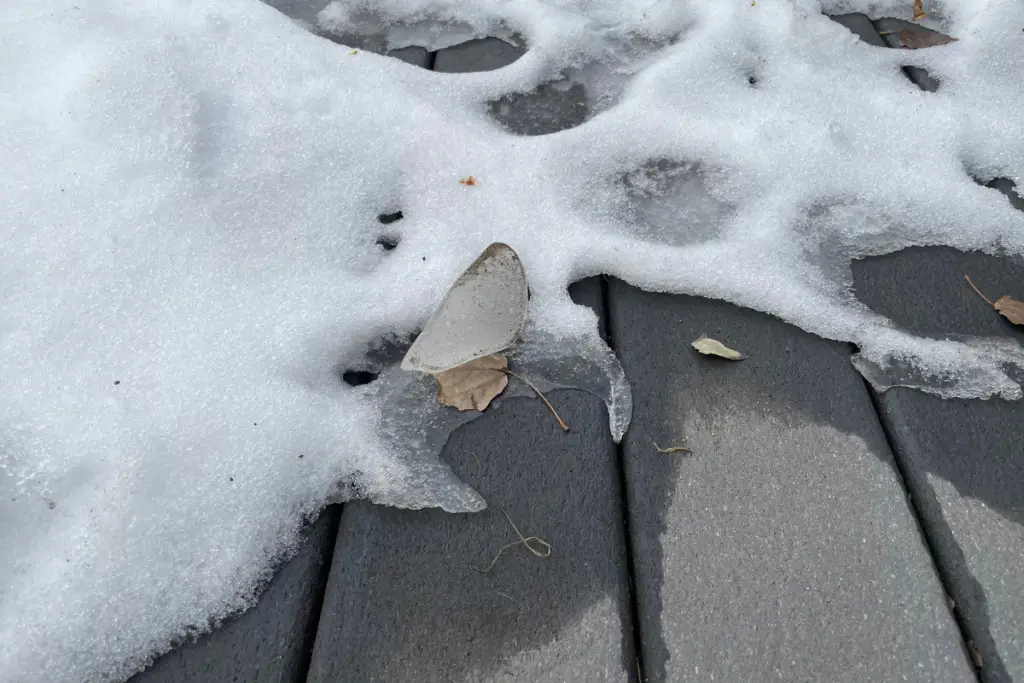You have a beautiful composite deck underneath all that snow and ice, and you can still enjoy it even in winter after removing the ice.
However, packed snow or ice will prevent you from being on your composite deck, and using an ice scraper would violate the warranty.

Is it possible to use salt to remove ice from composite decking?
It is safe to use Calcium Chloride ice melt on composite decking as long as it is free from colorants and traction additives. The safest ice salt for composite decking is Calcium Chloride.
Using salt on composite decking requires some consideration.
Most composite decking brands will not be damaged by salt.
But it’s always recommended to check with the specific brand of composite on your deck.
Composite decking with a protective cap are the most protected against damage from salt.
It’s important to use colourless and gritless salts that are safe for concrete surfaces. This will be less harsh on your composite decking.
Using plant-safe salt options for decks surrounded by plants is important to avoid harming them during winter and spoiling their summer beauty.
How to Deal with Ice on a Composite Deck
Living in regions with regular ice and snow requires adequate preparation for these weather conditions.
Including knowledge about how to remove ice and snow from your deck.

When clearing snow or ice from your composite decking, it is essential to carefully read and follow the instructions on any ice salt labels to ensure compatibility with your decking material.
Like I said, most but not all.
Look for phrases such as “safe for flagstone,” “will not kill grass,” and/or “safe for concrete.”
One aspect I appreciate about Green Gobble is its safety around pets and children. They often love running outside onto the deck just as much as we do, seeking respite from being cooped up indoors.
It’s always important to ensure that your salt is safe for children and pets.
Spreading salt on the ice can help it melt faster and lower its freezing point, allowing it to run off the decking.
This process is known as “freezing point depression.” While the ice is melting, more salt dissolves, thus causing more ice to melt away.
The result? A deck cleared of any ice and snow!
However, it’s important to ensure that the salt doesn’t harm any nearby plants. Most decks are sloped towards the yard, and melted ice can flow onto the deck’s vegetation. So always pick melts that are “plant safe.”
It’s important to note that using salt to remove ice on your decking may leave a little residue on the surface..
If this happens, follow these steps:
- Prepare the decking: Remove furniture and loose debris, such as leaves, using a stiff-bristle brush.
- Make a soapy solution – fill a bucket with hot water and add a cleaning solution of your choice. We recommend Wash Safe Industries WS-SC-1G Clear Spray and Clean Composite Deck Cleaner
 .
. - Apply the solution – tip the cleaning solution all over your decking and scrub with a stiff brush. Scrub in the direction of the surface’s grain so you don’t mark it.
- Rinse – once you have scrubbed your decking, wash the solution and dirt away with a hose or power washer. Your deck should now be clean and free of ice!
Shovelling Snow of a Composite Deck
Before putting salt on your composite decking, you must remove whatever snow is on the deck.
We recommend using a plastic blade shovel to remove the snow.
Avoid using a metal shovel or a snow shovel with a metal scraper on a composite deck. The metal will easily scratch the composite decking .
.
What To Avoid

Although salt is considered safe to use on composite decking, some factors should be considered before using any old ice melt.
Materials and tools to avoid when trying to remove ice and snow from your composite decking:
- Sand can provide traction on slippery surfaces, but it can also grind and damage decking over time.
- Ice melt with a colour additive – Certain dyes and ice melts can stain composite decking, so avoid them.
- Sharp-edge tools and metal shovels – Using a metal shovel or any sharp-edged tool can damage your decking, regardless of its strength. Light snow should be cleared with a plastic blade shovel or broom for best results.
After using salt on your composite decking, here’s what you need to know.
Once the snow and ice have melted from your decking’s surface, grab a broom and sweep away any remaining granular pieces. This simple step will prevent the granules from spreading to other areas, such as being tracked into your home.
After melting off the ice or snow, you may notice a buildup of calcium chloride and salt on your decking. This can be easily and quickly removed with a gentle surface wash.
It might be more suitable to wait until spring when the weather is warmer. You can use a garden hose to rinse off any lingering salt accumulation effectively at that time.
Alternatively, you can consider employing a sprinkler or a pressure washer.
With a pressure washer, ensure that the pressure is set to under 1,500 psi (For most Brands) and maintain a safe distance from the surface of the decking. It is advisable to hold the wand at least 12 inches above the deck to avoid any potential damage.
Click the link for specific water pressure and wand distance recommendations for different composite decking brands.
Keep in mind that some decking brands advise against using a pressure washer on their products, so make sure to check with the manufacturer before attempting this method.
Is Composite Decking As Slippery As Wood Decking?
When it comes to choosing decking that is less slippery, composite decking  is generally the better option.
is generally the better option.
While ice and snow can accumulate on composite decking during the winter, it tends to be less slippery than wooden decking.
Wood decking is more slippery than other surfaces because it is more porous and absorbs water more quickly. When temperatures drop, the water freezes, transforming the deck into an ice rink.
This not only poses a risk for walking but also leads to potential damage to the wood.
On the other hand, composite decking is shielded by a polymer cap, which prevents water absorption. However, it’s important to note that not all composite decking brands offer the same level of traction. While some surpass wood in terms of traction, others still pose a slipping hazard. Although water can accumulate on the surface of composite decking and potentially turn into ice, the composite material itself remains unharmed.
In Conclusion
With a few exceptions, it is generally safe to use salt and ice melt on composite decking.
However, always read the packaging label beforehand to ensure it is compatible with and suitable for your composite decking.
Plus, always avoid salts and ice melts that include chemicals that can stain composite decking.
